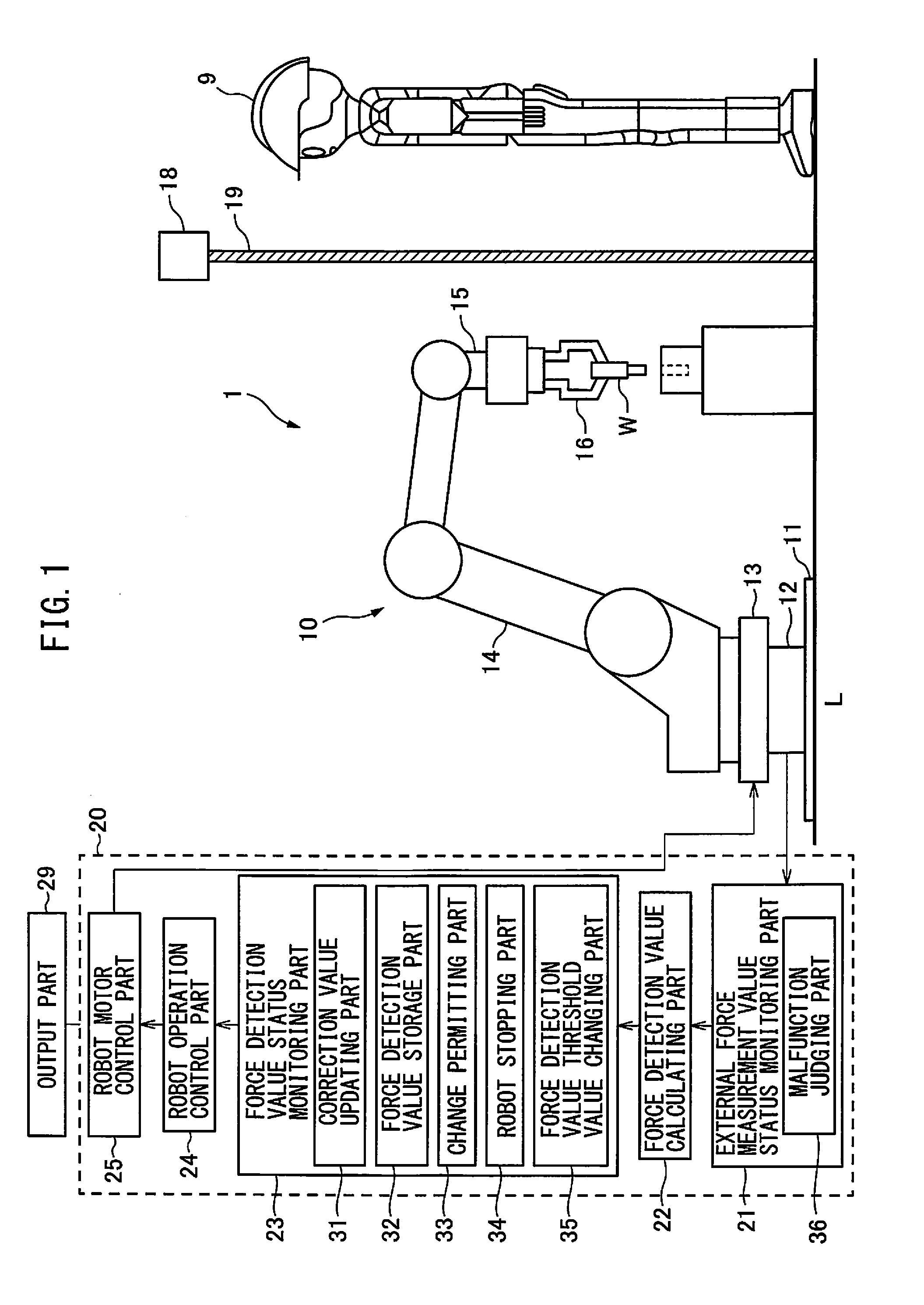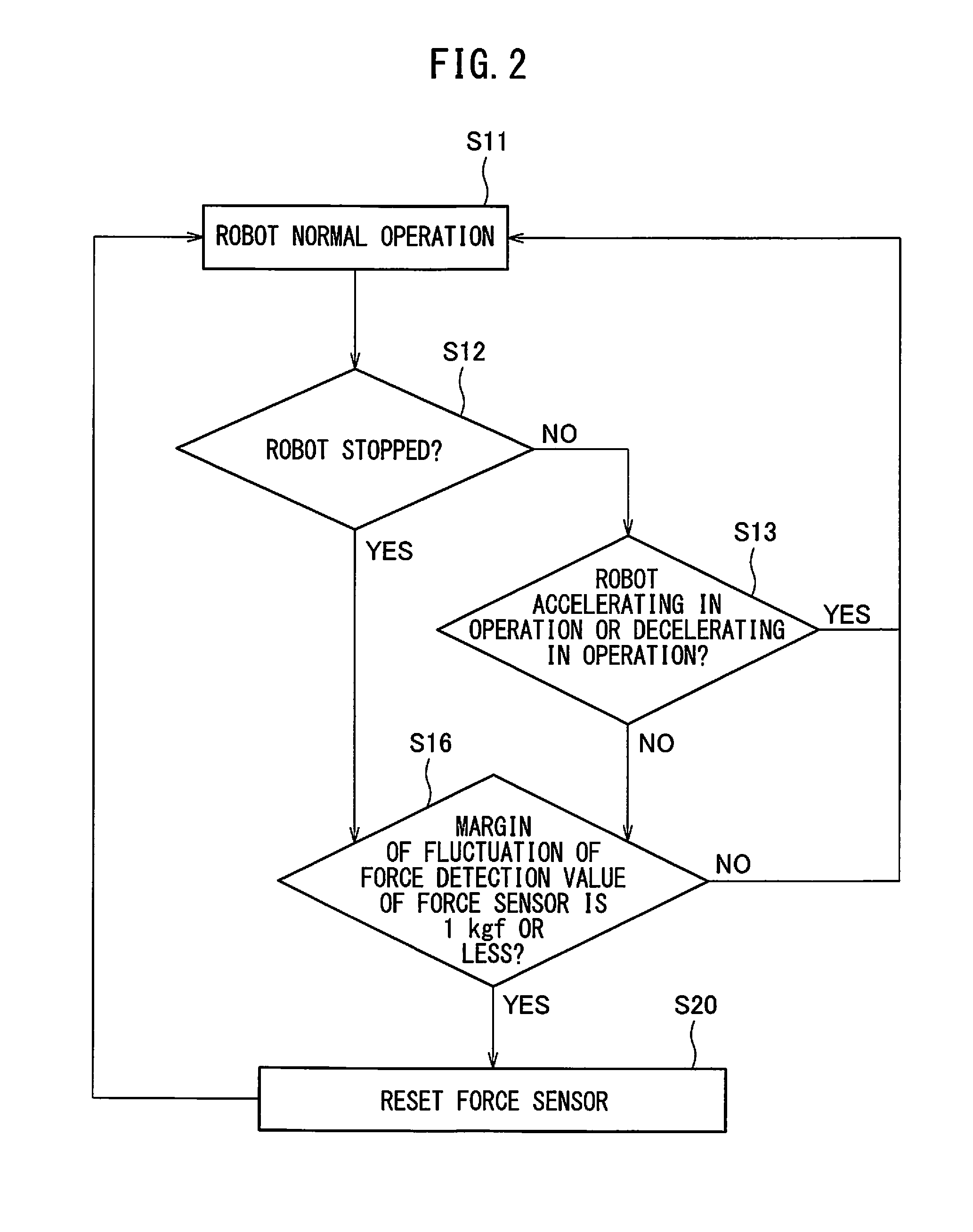Human-interactive type robot system
a robot system and robot technology, applied in the field of human-interactive robot systems, can solve the problems of robots that contact workers, injure workers, and increase the possibility of a worker being endangered, so as to achieve the effect of avoiding the updating of the correction value, reducing the risk to a worker, and raising the safety of the human-interactive robot system
- Summary
- Abstract
- Description
- Claims
- Application Information
AI Technical Summary
Benefits of technology
Problems solved by technology
Method used
Image
Examples
first embodiment
[0050]Further, in the first embodiment, the force sensor 12 is never reset in the state where it is acted on by an abnormally large force. Therefore, the measurement value of the force sensor 12 is never excessively corrected. For this reason, a drop in the precision of the force sensor 12 can also be simultaneously prevented.
[0051]In the prior art, the general practice is to update the correction value only when the robot 10 is stopped. As opposed to this, in the first embodiment, when the margin of fluctuation is the fluctuation margin threshold value or less, if the robot 10 is moving by a fixed speed, it is possible to judge that no inertia force due to accelerating or decelerating operation is being received. In such a case, the correction value can be updated. As a result, the correction value can be frequently updated, so the drift of the measurement value of the force sensor 12 can be constantly kept the smallest. Therefore, the precision of the force sensor 12 can be consta...
second embodiment
[0052]FIG. 3 is a flow chart which shows the operation of a human-interactive type robot system based on the present invention. In the flow chart which is shown in FIG. 3, at already explained parts, repeat explanations are omitted for the purpose of avoiding overlap. The same is true for the other later explained flow charts.
[0053]In FIG. 3, instead of step S16 which is shown in FIG. 2, step S16′ is arranged. At step S16′, the force detection value status monitoring part 23 judges if the current force detection value of the force sensor 12 is the force detection value threshold value, for example, 1.5 kgf, or less. Further, when the current force detection value is the force detection value threshold value or less, the routine proceeds to step S20 where the force sensor 12 is reset as explained above.
[0054]The predetermined condition in the second embodiment of the present invention is that the robot 10 be stopped or operating at a fixed speed and the current force detection value ...
third embodiment
[0058]FIG. 4 is a flow chart which shows the operation of a human-interactive type robot system based on the present invention. In FIG. 4, if it is judged at step S11 that the robot 10 is normally operating, the routine proceeds to step S17.
[0059]At step S17, the force detection value status monitoring part 23 judges if a predetermined time, for example, 10 minutes or more, has elapsed from when the force sensor 12 was previously reset. When a predetermined time or more has elapsed from the previous reset, the routine proceeds to step S20 where the force sensor 12 is reset. Note that, when a predetermined time has not elapsed from the time of the previous reset, the routine proceeds to step S12.
[0060]In this connection, the force detection value storage part 32 stores the force detection value when the predetermined condition stands. In the third embodiment, when resetting the force sensor 12, the correction value updating part 31 reads out the stored force detection value from the ...
PUM
 Login to View More
Login to View More Abstract
Description
Claims
Application Information
 Login to View More
Login to View More - R&D
- Intellectual Property
- Life Sciences
- Materials
- Tech Scout
- Unparalleled Data Quality
- Higher Quality Content
- 60% Fewer Hallucinations
Browse by: Latest US Patents, China's latest patents, Technical Efficacy Thesaurus, Application Domain, Technology Topic, Popular Technical Reports.
© 2025 PatSnap. All rights reserved.Legal|Privacy policy|Modern Slavery Act Transparency Statement|Sitemap|About US| Contact US: help@patsnap.com



